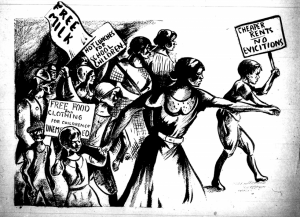Women’s roles in society diversified in the 20th century, but motherhood and domestic duties remained the primary role for most women. The idealized roles for women that focuses on the domestic sphere has roots in upper-middle-class Victorian England. The emphasis on the domestic creates certain expectations for women: that they will first and foremost be mothers, that they will cook and clean and shop and take care of the family. In the United States, the domestic has been a rallying point for women’s engagement in the public, political sphere since the Revolutionary era.[1] Yet the call to public action through the domestic can be an area of tension as traditional household and parental duties conflict with political work outside the home. Clara Shavelson’s life is no exception, and these tensions are evident in her life and work.
During Shavelson’s lifetime, women were active in the public sphere; in the workforce, and in the labor, anti-war, and suffrage movements. For white women, their involvement in these public sphere activities lessened or stopped altogether upon marriage and motherhood. Once the domestic became their primary sphere, it became an effective way to motivate women to take political action. For some this strategy was deployed from an essentialist point of view; that women were inherently maternal and domestic, and this was the best way to appeal to them. For Shavelson, this was simply a way in, a door to increased political socialization and social action.
Certainly within the Communist Party, the relationship between motherhood and activism was critical. Some of the most famous women within the Communist Party were known not by their first names, but as “mother”. Mother Jones, Mother Bloor, Mother Gitlow. Women’s domestic role is simultaneously public. They were expected to raise and nurture the next generation of workers and radicals. The responsibility to raise radical children was one Shavelson took seriously, and all three of her children became political activists. She also inspired other neighborhood children to be become politically active. However, viewing women as “mother” only is not without its problems, not least of which is the reduction of women to a single role that downplays their other contributions.
Placing primacy on women’s roles as mothers and domestic caretakers inevitably leads to conflict between this role and that of political activism. What is known about Shavelson’s family life comes primarily from Annelise Orleck’s interviews with her family members and friends. According to these sources Shavelson had a “fierce insistence on her right to do political work outside the home”[2] and this insistence was both a point of pride within the family but also a point of conflict.
Despite her husband Joe’s theoretical acceptance of women’s equality, Shavelson still found herself responsible for the majority of the cooking and child care, as well as contraception. Shavelson accepted these responsibilities “not without anger”[3] and felt she was forced to make choices between her political activity and domestic duties. When she expressed her expectation that Joe and the children help with the housework, there was a “good deal of resentment” from the family.[4]
Beyond the division of duties, the amount of time her political work kept her away from home was also a point of conflict with Shavelson’s children. Martha particularly admired the work their mother did, but at the same time wished for her to be home more often. This issue came to a head when, in 1934, Shavelson traveled to Paris for the International Women’s Congress Against War and Fascism, and then to the Soviet Union. This was the first opportunity for Shavelson to return to her native land, and by all accounts the trip was an important one for her. Yet for her daughters, Martha 17, and Rita 10, their mother’s decision to leave them at home for an extended period of time rankled.
The rent strikes and food boycotts that Shavelson participated in are primary examples of how starting with a shared domestic concern can encourage political activism for those who may not feel comfortable expressing political opinions in other ways. However, these actions were just the beginning. Shavelson organized reading groups and discussions about political theory for the newly-minted activist housewives to connect their actions with larger political thought.
For Shavelson, her commitment to political action was essential to her life, as essential as her family. She felt strongly the intersection of gender and class and the need to address inequalities around both, within and outside the home. She utilized the shared domestic concerns as a starting point for inclusive women’s political action, while simultaneously navigating in her own home the conflict between family and activism.
—
[1] Skemp, Sheila L. “Women and Politics in the Era of the American Revolution.” Oxford Research Encyclopedia of American History.
[2] Orleck, Common Sense & a Little Fire, 247.
[3] Ibid., 307.
[4] Ibid., 244.



